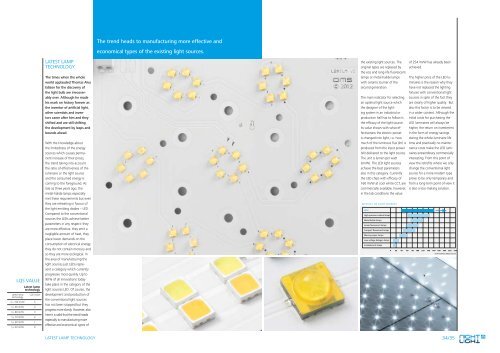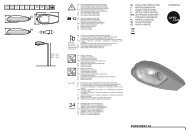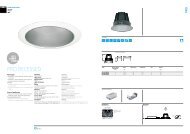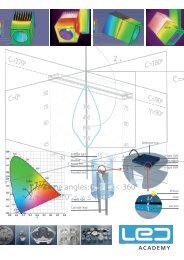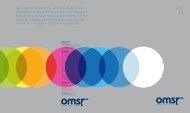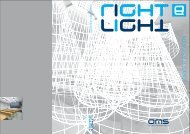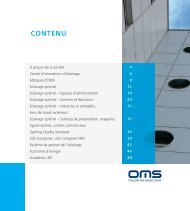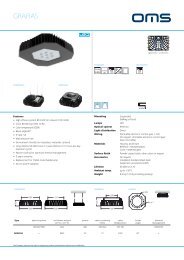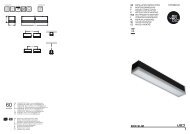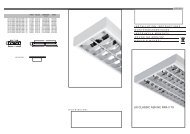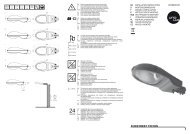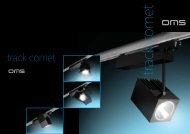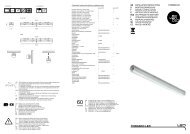Download PDF Catalogue - OMS lighting
Download PDF Catalogue - OMS lighting
Download PDF Catalogue - OMS lighting
You also want an ePaper? Increase the reach of your titles
YUMPU automatically turns print PDFs into web optimized ePapers that Google loves.
The trend heads to manufacturing more effective and<br />
economical types of the existing light sources.<br />
LQS VALUE<br />
Latest lamp<br />
technology<br />
Latest lamp LQS Value<br />
technology<br />
> 100 lm/W 5<br />
> 90 lm/W 4<br />
> 80 lm/W 3<br />
> 70 lm/W 2<br />
> 60 lm/W 1<br />
> 50 lm/W 0<br />
LATEST lamp<br />
TECHNOLOGY<br />
The times when the whole<br />
world applauded Thomas Alva<br />
Edison for the discovery of<br />
the light bulb are irrecoverably<br />
over. Although he made<br />
his mark on history forever as<br />
the inventor of artificial light,<br />
other scientists and inventors<br />
came after him and they<br />
shifted and are still shifting<br />
the development by leaps and<br />
bounds ahead.<br />
With the knowledge about<br />
the limitedness of the energy<br />
sources which causes permanent<br />
increase of their prices,<br />
the trend taking into account<br />
the ratio of effectiveness of the<br />
luminaire or the light source<br />
and the consumed energy is<br />
coming to the foreground. As<br />
late as three years ago, the<br />
metal-halide lamps especially<br />
met these requirements but even<br />
they are retreating in favour of<br />
the light emitting diodes – LED.<br />
Compared to the conventional<br />
sources the LEDs achieve better<br />
parameters in any respect: they<br />
are more effective, they emit a<br />
negligible amount of heat, they<br />
place lower demands on the<br />
consumption of electrical energy,<br />
they do not contain mercury and<br />
so they are more ecological. In<br />
the area of manufacturing the<br />
light sources just LEDs represent<br />
a category which currently<br />
progresses most quickly. Up to<br />
90 % of all innovations today<br />
take place in the category of the<br />
light sources LED. Of course, the<br />
development and production of<br />
the conventional light sources<br />
has not been stopped but they<br />
progress more slowly. However, also<br />
here it is valid that the trend heads<br />
especially to manufacturing more<br />
effective and economical types of<br />
Latest lamp technologY<br />
the existing light sources. The<br />
original types are replaced by<br />
the eco and long-life fluorescent<br />
lamps or metal-halide lamps<br />
with ceramic burner of the<br />
second generation.<br />
The main indicator for selecting<br />
an optimal light source which<br />
the designer of the <strong>lighting</strong><br />
system in an industrial or<br />
production hall has to follow is<br />
the efficacy of the light source.<br />
Its value shows with what effectiveness<br />
the electric power<br />
is changed into light, i.e. how<br />
much of the luminous flux (lm) is<br />
produced from the input power<br />
(W) delivered to the light source.<br />
The unit is lumen per watt<br />
(lm/W). The LED light sources<br />
achieve the best parameters<br />
also in this category. Currently<br />
the LED chips with efficacy of<br />
160 lm/W at cool white CCT, are<br />
commercially available, however,<br />
in the lab conditions the value<br />
EFFICACY OF LIGHT SOURCEs<br />
LEDs<br />
High-pressure sodium lamps<br />
Metal halide lamps<br />
Linear fluorescent lamps<br />
Compact fluorescent lamps<br />
Mercury vapor lamps<br />
Low voltage halogen lamps<br />
Incandescent lamps<br />
of 254 lm/W has already been<br />
achieved.<br />
The higher price of the LED luminaires<br />
is the reason why they<br />
have not replaced the <strong>lighting</strong><br />
fixtures with conventional light<br />
sources in spite of the fact they<br />
are clearly of higher quality. But<br />
also this factor is to be viewed<br />
in a wider context. Although the<br />
initial costs for purchasing the<br />
LED luminaires will always be<br />
higher, the return on investment<br />
in the form of energy savings<br />
during the whole luminaire life<br />
time and practically no maintenance<br />
costs make the LED luminaires<br />
extraordinary commercially<br />
interesting. From this point of<br />
view the retrofits where we only<br />
change the conventional light<br />
source for a more modern type<br />
prove to be only temporary and<br />
from a long-term point of view it<br />
is also a loss-making solution.<br />
0 20 40 60 80 100 120 140 160 180 200 220 240<br />
lm/W (without ballast losses)<br />
34/35


